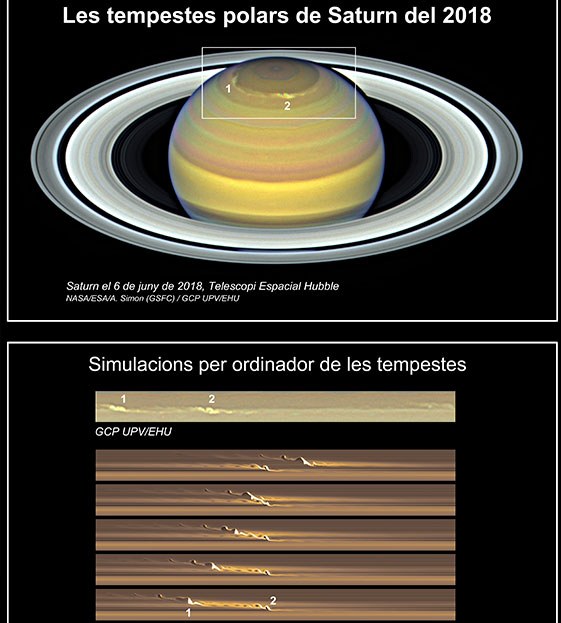Enrique García and Manel Soria reproduce the formation of polar storms on Saturn
Oct 24, 2019
The work of researchers Enrique García and Manel Soria of the Department of Physics of the UPC, is part of an international scientific collaboration led by the researcher Agustín Sánchez Lavega, from the University of the Basque Country (UPV / EHU), which has discovered multiple storms at different latitudes of the second largest planet in the solar system and just published in the journal "Nature Astronomy"
Researchers Enrique García and Manel Soria, from Turbulence and Aerodynamics in Mechanical and Aerospace Engineering Research Group (TUAREG) of the Polytechnic University of Cataluya · BarcelonaTech (UPC), have developed a numerical model with which, through supercomputers, you can reproduce the evolution of polar storms on Saturn and identify the conditions that have caused them. The work has just been published in the journal 'Nature Astronomy' and is part of an international project that has involved the Cassini space mission of the US, European and Italian space agencies, which was in orbit of the planet until September 2017. In addition , the project has had the Hubble space telescope, the PlanetCam camera of the UPB / EHU installed in the Calar Alto Observatory, the numerical simulations carried out by the UPC and the participation of a network of amateur observers who have contributed the images to follow Day by day the evolution of the phenomenon.
It all started on the night of March 29, 2018, when a Brazilian amateur astronomer captured with his telescope the presence of a small, but bright, white spot on the disk of the planet Saturn, near its north pole. A few days later the stain became large, reaching about 4,000 km in length and becoming the most remarkable detail of the disk of the planet of the rings. About two months later a second spot appeared, more towards the north of the planet, and in the following months sequentially, a third and a fourth spots, much closer to the polar region, on the banks of the famous Saturn hexagon, a phenomenon that had never been observed before.
During those months the spots moved at different speeds, dragged by the atmospheric winds that blow Saturn in strong currents to the east and west. While the first spot, located farther south, moved about 220 km / hour to the east, the one farther north was about 20 km / h to the west. This caused encounters between them, passing close to each other and generating, during their mutual interaction, atmospheric disturbances that spread around the entire polar region of Saturn.
The researchers Enrique García and Manel Soria, of the UPC, have created a numerical model that allows to evaluate and reproduce the evolution of the polar storms that take place in Saturn and the energy involved in its development, comparing them with the other types of storms observed previously. In this way, storms have been identified for the first time at different latitudes of this planet that are triggered by convection in deep clouds of water about 200 km below the visible clouds of the planet of the rings. The hot and humid gas rises very strongly to Saturn's hydrogen atmosphere forming very dense clouds of ammonia, visible with the telescope.
Sánchez-Lavega, A., E. García-Melendo, J. Legarreta, R. Hueso, T. del Río-Gaztelurrutia, J. F. Sanz-Requena, S. Pérez-Hoyos et al. "A complex storm system in Saturn’s north polar atmosphere in 2018." Nature Astronomy (2019): 1-8.

Share: